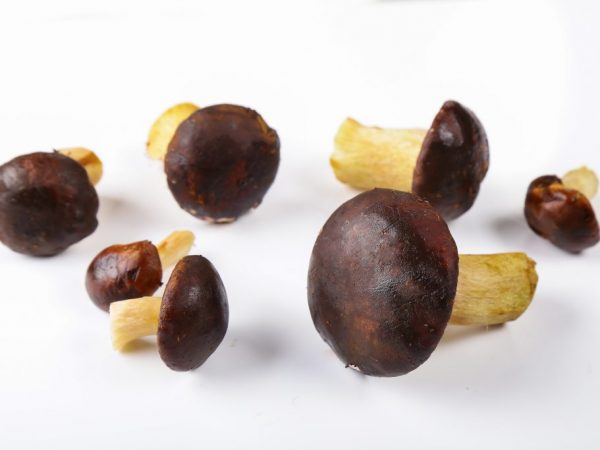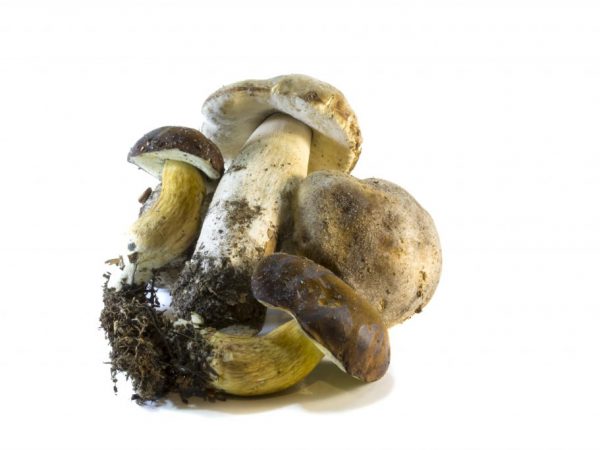Characteristics of the Polish mushroom
The Polish mushroom is a bright representative of the kingdom of Mushrooms, which, according to one classification, belongs to the Borovik genus, according to the other to the Mohovik genus, and is also isolated even into a separate genus - Imleria, which also emerges into the Boletov family.

Characteristics of the Polish porcini mushroom
Where does the Polish mushroom grow
The name of the Polish mushroom was due to the place of greatest distribution. In Poland, this type of mushroom is the leader in terms of collection. In Russia, it is often called the chestnut mushroom, pansky or brown mushroom. It grows in the European part and in the Far East. In Europe it is considered a delicacy due to its rich taste and nutrient content. The Polish mushroom and North America did not bypass their "attention".
Polish mushrooms prefer mixed or coniferous forests with acidic soils in the northern temperate zone. The collection time for this species is from June to October. Under favorable weather conditions, the peak yield occurs in September.
The fungus grows at the bases of old trees: firs, oaks, beeches - either next to stumps, in groups or one at a time, forming mycorrhiza with them. Belongs to the Boletov family from the Borovik family.
Description and useful properties
To choose the right one, the mushroom picker needs to know the exact description of the Polish mushroom:
- Hat: brown, with a diameter of 3 to 15 cm. The shape is convex, at the beginning of growth, the edges are rolled up, then it takes on a flatter appearance. The surface is velvety, in dry weather it remains dry, and in wet weather it becomes slimy and slippery, while it has the property of being difficult to separate.
- Cap color: ranges from bright red-brown to dark chestnut-brown.
- Hymenophore: tubular, initially (in young mushrooms) has a light yellowish tint, which becomes greenish as it grows. This shade changes with mechanical stress, becoming bluish, blue-green or even brownish-brown.
- Pulp: white color, dense consistency, slightly blue on the cut, then turns brown and again becomes white.
- Smell: light, fruity or mushroom.
- Taste: pleasant, sweetish.
- Leg: reaches 14 cm in height, up to 4 cm in diameter, cylindrical, slightly swollen at the bottom, can have a curved shape. The color is always lighter than the hat, in brown tones (yellow in the upper part). When pressed on it, it first turns slightly blue, then becomes brown.
How to tell a false Polish mushroom
False counterparts of the Polish mushroom are easy for inexperienced mushroom pickers to confuse with the Polish porcini mushroom. The most common types of doubles are flywheels (motley flywheel, m brown, m green). This category of mushrooms is not dangerous, but they are not used for cooking.
Their main external difference is a red-brown cap with cracks through which one can see a red-pink flesh (in a variegated flywheel) or light yellow (in a green flywheel) and a light yellowish leg.In a brown flywheel, dry whitish-yellow flesh is visible through cracks in a dark brown or dark brown cap.
Often inexperienced doubles are confused with birch white or spruce white mushroom, which in itself is very strange, tk. it is very difficult to find common features between these species in appearance. If we take the differences, then we can distinguish:
- the porcini mushroom has a barrel-shaped stem;
- the pulp on the break does not turn blue;
- there is a clearly visible convex mesh on the surface of the leg, etc.
You can also say that the Polish mushroom, again extremely inattentive mushroom pickers, can be confused with bile fungus.
Collection features

Don't pick mushrooms along the roads
Like any mushroom, the Polish mushroom is capable of accumulating hazardous substances from the environment in the fruiting body. Therefore, for safety reasons, you should refrain from collecting along roads and near industrial sites.
To preserve the mycelium, the fruiting body is recommended to be cut carefully and make sure it is edible. After that, carefully examine the mushrooms for the presence of worms (insect larvae): one infected person can spoil the entire contents of the basket in a few hours.
If the wormy areas are small, they can be trimmed neatly. It is desirable to choose young specimens: they are better in taste. Old and overripe can cause eating disorders.
After returning from the forest, the collected mushrooms are processed within 24 hours. With longer storage, they overheat, cake and deteriorate.
Useful properties and contraindications
According to its nutritional properties, the Polish mushroom belongs to foods with a high content of vitamins and microelements. At the same time, the content of calories in it does not exceed 19 kcal per 100 g of pulp, which makes it dietary:
- proteins - 1.7 g;
- fats - 0.7 g;
- carbohydrates - 1.5 g.
Polish mushroom (fruit body extract) contains antioxidants, thiamine and other essential amino acids with a number of beneficial properties:
- calm the nervous system;
- help to lower blood pressure;
- reduce the risk of developing atherosclerosis;
- improve the condition of nails and hair;
- help to reduce weight.
The following vitamins are present in the chemical composition of the pan mushroom:
- Groups B (B1, IN2, IN9, IN12);
- Ascorbic acid (C).
Also, the following macro- and microelements were found in its composition:
- potassium;
- phosphorus;
- iron;
- zinc;
- calcium;
- manganese;
- fluorine;
- sodium;
- magnesium;
- copper;
- selenium.
The Polish mushroom has an interesting property - the ability to cleanse the soil from heavy metals and accumulated radiation (absorbs it). It is also used in traditional medicine. The Pan mushroom is used in traditional Chinese medicine, where it is used to reduce weight, blood pressure and as a sedative.
Irina Selyutina (Biologist):
The famous Russian mycologist M. Vishnevsky writes about Polish mushrooms that:
- Studies have shown that the alcoholic extract obtained on the basis of fresh fruit bodies contains polysaccharides with antitumor activity against sarcoma-180 and Ehrlich's carcinoma (experiments were carried out on mice) by 60 and 70%, respectively.
- Methanol (CH3OH) extract based on dried fruit bodies showed high antioxidant activity. But the same extract, but obtained using fresh fruit bodies, showed excellent results in neutralizing active oxygen in comparison with all known types of mushrooms with the same antioxidant properties.
- Polish researchers managed to find out that this type of edible mushroom is a hyperaccumulator of mercury, cobalt, cadmium and lead contained in the soil. After the accident that occurred at the Chernobyl nuclear power plant in 1986, they established hyperaccumulation of radioactive cesium-137.
- Currently, the development of a method for using the Polish fungus for cleaning the soil in those places that have undergone such a specific infection is underway.
In addition to the benefits, mushroom dishes can also cause harm. For example, people who have problems with the digestive system. A large number of mushrooms eaten can cause digestive upset. Interestingly, the Polish mushroom is one of the species that does not have poisonous counterparts.
Cooking and eating
To prepare for cooking, the contents of the basket are poured onto a flat, dry surface, carefully inspected, getting rid of spoiled and too old ones. After making sure that all specimens are edible, remove the spoiled areas, cut off the lower part with the remnants of mycelium, debris and dirt. By the way. The thin skin covering the cap does not need to be removed.
After thorough rinsing under running water, the mushrooms are soaked for 15-20 minutes, salt is added. Then they are washed again, the small ones are left intact, and the large ones are cut into pieces.
When cooking Polish mushrooms, the first broth is drained, then poured over with water and boiled with the addition of salt and spices. Further, mushrooms are used for frying, stewing, freezing, drying or pickling.
Polish mushrooms are characterized by professional culinary specialists, not only as a species with a delicate taste and pleasant aroma, but practically does not boil down during cooking and does not lose its qualities during heat treatment.
However, in spite of their good taste, you should not use them raw for salads - it is better for these purposes either to pre-fry or boil them.
Conclusion
The Polish mushroom, like the white one, has a pleasant light aroma and a rich mushroom taste. The chestnut mushroom belongs to the same family as the porcini mushrooms, which is why they are often called boletus. When collecting, it is important to carefully examine each find. The mock Polish mushroom looks almost like an edible counterpart.



